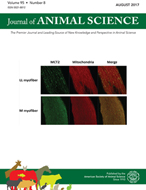-
Views
-
Cite
Cite
M. K. Griffith, J. E. Minton, Effect of light intensity on circadian profiles of melatonin, prolactin, ACTH, and cortisol in pigs, Journal of Animal Science, Volume 70, Issue 2, February 1992, Pages 492–498, https://doi.org/10.2527/1992.702492x
Close - Share Icon Share
Abstract
Eleven crossbred barrows were housed in environmentally controlled rooms with an 8-h photoperiod. Pigs in one room received control illumination of 113 lx (CON; n = 6), and pigs in the other room received intense illumination of 1,783 lx (INT; n = 5) fluorescent light. Pigs were given at least 20 d of exposure to the environment before blood samples were taken every 3 h for 48 h. Data were analyzed by split-plot analysis of variance. Except for prolactin, no treatment × time interactions were noted for the hormone profiles evaluated (P > .10). Pigs in INT had greater (P < .05) concentrations of prolactin in serum than pigs in CON at every sampling time. Concentrations of ACTH and Cortisol in plasma were similar for INT (33.9 ± 3.2 pg/mL of ACTH and 24.4 ± 3.4 ng/mL of Cortisol, respectively) and CON (34.9 ± 3.0 pg/mL of ACTH and 31.3 ± 3.1 ng/mL of Cortisol, respectively). Within the INT treatment, serum melatonin concentrations were more than doubled (P < .05) during darkness (66.8 ± 9.3 pg/mL) compared with during light (30.4 ± 9.3 pg/mL); however, within the CON treatment, concentrations during light and darkness did not differ (38.4 ± 9.3 pg/mL and 42.9 ± 9.3 pg/mL, respectively). Results indicate that light of greater intensity is required to entrain circadian rhythms of melatonin in serum of pigs. Furthermore, pigs may respond to bright light with greater secretion of prolactin, even under constant duration of photoperiod.





